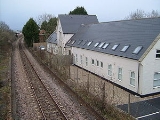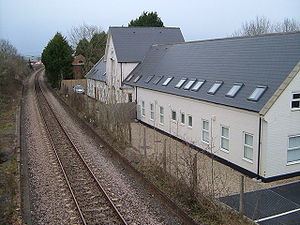
Broad Clyst railway station
Encyclopedia
Broad Clyst railway station is a disused railway station on the West of England Main Line
which served the nearby village of Broadclyst
from 1860 until its closure in 1966.
to the Gothic
designs of Sir William Tite
, Broad Clyst station was actually more than a mile away from the small village of Broadclyst from which it was to draw most of its traffic. The naming of the station proved to be a source of controversy with the railway company preferring "Broad Clyst" over the Post Office
's insistence that a single word be used. The station attracted residential development in the immediate area and even today the area around the former station is known as Broadclyst Station.
The station saw little change during its 106 year life, it had two short platforms - the Up one was capable of accommodating four carriages and the Down one only three; they were never extended as the station only served local trains. The station was lit by oil lamps until its closure. A small Chief Engineers' depot was located on the Up side and this was extended in 1929 with the laying of additional siding
s. At the depot was based a small departmental engine used for shunting operations.
The station saw mainly passenger traffic and goods traffic was fairly light, particularly as there was no resident coal merchant. Nevertheless, from the early 1960s a local manufacturer of three-wheel invalid cars began regularly sending his goods by rail. However, the decision was taken in 1963 to close the engineers' depot and, in 1965, to concentrate goods traffic on Exeter. At the same time, the Broad Clyst station itself was put forward for closure as part of the package of economies proposed by the Beeching Report. Goods traffic ceased in 1965, with passenger traffic ending the following year.
 In 1998 a proposal was discussed in the House of Commons
In 1998 a proposal was discussed in the House of Commons
to open a station at Broadclyst which would serve a new settlement of 3,000 houses be constructed nearby and to be known as "Clyst Hayes", although this has since been changed to "Cranbrook
". The location of the settlement has yet to be finally decided, but the requirement to provide a station is now provided for in the district's local plan.
The former station building and goods shed remain in commercial use on the Down side. The station building was completely renovated in 2006.
West of England Main Line
The West of England Main Line is a British railway line that runs from , Hampshire to Exeter St Davids in Devon, England. Passenger services run between London Waterloo station and Exeter...
which served the nearby village of Broadclyst
Broadclyst
Broadclyst is a village and civil parish that lies approximately 5 miles northeast of the city of Exeter, in the district of East Devon, England, on the B3181. In 2001 its population was 2830....
from 1860 until its closure in 1966.
History
Constructed by the London and South Western RailwayLondon and South Western Railway
The London and South Western Railway was a railway company in England from 1838 to 1922. Its network extended from London to Plymouth via Salisbury and Exeter, with branches to Ilfracombe and Padstow and via Southampton to Bournemouth and Weymouth. It also had many routes connecting towns in...
to the Gothic
Gothic Revival architecture
The Gothic Revival is an architectural movement that began in the 1740s in England...
designs of Sir William Tite
William Tite
Sir William Tite, CB was an English architect who served as President of the Royal Institute of British Architects. He was particularly associated with various London buildings, with railway stations and cemetery projects....
, Broad Clyst station was actually more than a mile away from the small village of Broadclyst from which it was to draw most of its traffic. The naming of the station proved to be a source of controversy with the railway company preferring "Broad Clyst" over the Post Office
Royal Mail
Royal Mail is the government-owned postal service in the United Kingdom. Royal Mail Holdings plc owns Royal Mail Group Limited, which in turn operates the brands Royal Mail and Parcelforce Worldwide...
's insistence that a single word be used. The station attracted residential development in the immediate area and even today the area around the former station is known as Broadclyst Station.
The station saw little change during its 106 year life, it had two short platforms - the Up one was capable of accommodating four carriages and the Down one only three; they were never extended as the station only served local trains. The station was lit by oil lamps until its closure. A small Chief Engineers' depot was located on the Up side and this was extended in 1929 with the laying of additional siding
Rail siding
A siding, in rail terminology, is a low-speed track section distinct from a running line or through route such as a main line or branch line or spur. It may connect to through track or to other sidings at either end...
s. At the depot was based a small departmental engine used for shunting operations.
The station saw mainly passenger traffic and goods traffic was fairly light, particularly as there was no resident coal merchant. Nevertheless, from the early 1960s a local manufacturer of three-wheel invalid cars began regularly sending his goods by rail. However, the decision was taken in 1963 to close the engineers' depot and, in 1965, to concentrate goods traffic on Exeter. At the same time, the Broad Clyst station itself was put forward for closure as part of the package of economies proposed by the Beeching Report. Goods traffic ceased in 1965, with passenger traffic ending the following year.
The station today

British House of Commons
The House of Commons is the lower house of the Parliament of the United Kingdom, which also comprises the Sovereign and the House of Lords . Both Commons and Lords meet in the Palace of Westminster. The Commons is a democratically elected body, consisting of 650 members , who are known as Members...
to open a station at Broadclyst which would serve a new settlement of 3,000 houses be constructed nearby and to be known as "Clyst Hayes", although this has since been changed to "Cranbrook
Cranbrook, Devon
Cranbrook is the name chosen for a new town in East Devon, it will initially consist of 2,900 residential properties as well as all the required infrastructure to support a town of this size....
". The location of the settlement has yet to be finally decided, but the requirement to provide a station is now provided for in the district's local plan.
The former station building and goods shed remain in commercial use on the Down side. The station building was completely renovated in 2006.

